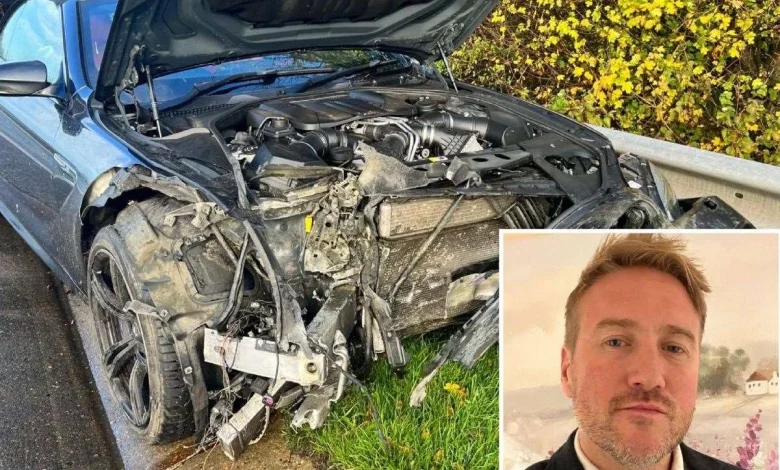Man who pulled motorist from pond after crash warns of accident blackspot

A dad-of-two who helped pull another motorist from a pond after an accident says action is needed to make the road safer and prevent further crashes.
Conor Hardy from Tonbridge smashed into the central reservation of the south-bound A21 Tonbridge bypass, just before the A26 turn-off, after his car aquaplaned on a rainy day.
Conor Hardy crashed on the A21 Tonbridge bypass because of surface water. Picture: Conor Hardy
“All I knew was I’d hit water, and I was on the side of the road,” the 44-year-old told KentOnline.
After managing to pull the car into the grass bank on the side of the road, he remembers being “quite shaken” and, as he looked down the road, realised two other cars had crashed too.
Moments later, he saw a paramedic in a lay-by grabbing a crowbar from the ambulance and as he asked what was happening, he learned another car was also upside down in a nearby pond.
Together, Conor and ambulance staff used the crowbar to hack away at the windscreen and create a hole big enough to pull the man out.
Miraculously, although he had visible cuts and bruises, the guy pulled from the water was okay and he was taken to hospital by ambulance.
Conor Hardy wants to warn motorists about a stretch of the A21 Tonbridge bypass which has drainage problems. Picture: Conor Hardy
Conor said: “I was pretty shaken up about the whole thing to be honest with you.
“It happened so quickly and you’re like ‘oh my god, I have no control of this situation.’”
His accident happened in November 2022, and three other accidents occurred in the same 300-metre radius that same year, according to crash map data.
Since 2022, there have been eight accidents in the same area, and in March last year a driver died in a nearby spot after a car overturned and landed in a water-filled ditch.
The driver of a red Citroen C4, a man in his 50s, died at the scene.
Crash data within a 300-metre radius of a specified location on the A21, Tonbridge, south-bound carriageway, which is a National Highways road. Picture: Editorial Graphics
National Highways says safety is its “top priority” and it regularly inspects and sweeps the route to ensure surface water is draining from the carriageway.
But drinks company founder Conor said: “Where the actual 300m radius is, that’s where the gulley stops, and the water just pools in the middle of the road, so it has nowhere to drain.
“The drainage is obviously bad, and the puddle spreads out across the highway, and it seems to be particularly bad on the south-bound carriageway.
“People are hitting that at 70mph and losing control of their cars.
Conor Hardy crashed on the A21 Tonbridge bypass because of surface water. Picture: Conor Hardy
“Knowing that most of the people I know and love drive down the road all the time, it feels like we need action.”
In this year alone, National Highways has swept the area 36 times, which Conor believes illustrates the problem at hand, and says a preventative rather than reactive solution is needed.
National Highways explained that wildlife and environmental regulations, including nesting birds in the summer, have previously prevented the company, which is responsible for maintaining and improving major A-roads, from cutting back the vegetation.
Although a temporary warning sign was put in place after Conor wrote to National Highways about his concerns, he says a permanent solution is needed.
He said: “It’s not really enough to warn people, they need to fix the drainage and put a crash barrier across where that embankment is down into the pond. I think that is something they need to urgently put in.
Conor Hardy crashed on the A21 Tonbridge bypass because of surface water. Picture: Conor Hardy
“Clearly there is a problem, sweeping helps, but it’s not addressing the underlying issue of the drainage there.
“It’s kind of like treating the symptoms but not having a cure for the issue.”
Conor hopes that by highlighting the safety concerns over this stretch of road he can warn others and prevent further accidents until a solution is found.
A National Highways spokesperson said: “Safety is our top priority, and we regularly inspect and sweep this route to ensure that surface water is draining from the carriageway.
“We will soon be cutting back vegetation which will further help the drainage to perform as designed.”





